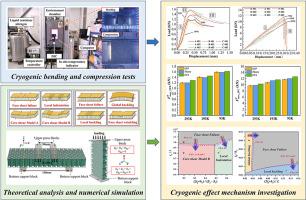Cryogenic mechanics and failure behaviors of CFRP/Aluminum honeycomb sandwich structures
IF 9.8
1区 材料科学
Q1 MATERIALS SCIENCE, COMPOSITES
引用次数: 0
Abstract
Sandwich structures composed of carbon fiber reinforced polymer (CFRP) and aluminum honeycomb have been widely used in aerospace applications due to their high stiffness and strength. However, the cryogenic reliability of composite sandwich structures remains challenging due to the complex temperature effects on their mechanical performances and failure modes. Herein, the temperature-dependent mechanical behaviors of CFRP/aluminum sandwich structures were investigated through experimental testing, theoretical analysis, and numerical simulation. The failure behaviors were explored through four-point bending and in-plane compression experiments of composite sandwich structures under various temperatures (293 K, 193 K, and 93 K). The effects of dimension and temperature on failure modes were analyzed, and temperature-dependent failure maps were deduced. The results showed an increase in the bending and compression ultimate loads of composite sandwich structures as a function of the decrease in temperature. As the temperature dropped from 293 K to 93 K, the flexural strength of the specimens increased by 33 %, mainly due to the rise in the shear strength of the honeycomb core. Meanwhile, the compressive strength of the specimens rose by 21 % owing to the enhancement of the face sheet. Failure maps showed a more susceptible bending process to the compression failure of face sheet at cryogenic temperatures, while the in-plane compression process was less susceptible to face sheet failure due to the cryogenic reinforcement of the composite. Overall, the proposed approach can efficiently be utilized to analyze the cryogenic bearing performance and failure mode of composite sandwich structures, promising for cryogenic applications.

CFRP/铝蜂窝夹层结构的低温力学及破坏行为
由碳纤维增强聚合物(CFRP)和铝蜂窝组成的夹层结构由于其高刚度和高强度而广泛应用于航空航天领域。然而,由于复合材料夹层结构的力学性能和失效模式受到复杂的温度影响,其低温可靠性仍然是一个挑战。本文通过实验测试、理论分析和数值模拟研究了CFRP/铝夹层结构的温度相关力学行为。通过对复合材料夹层结构在不同温度(293 K、193 K和93 K)下的四点弯曲和面内压缩试验,探讨了复合材料夹层结构的破坏行为。分析了尺寸和温度对失效模式的影响,推导了温度相关的失效图。结果表明:复合材料夹层结构的弯曲和压缩极限载荷随温度的降低而增大;当温度从293 K降至93 K时,试件的抗折强度提高了33%,这主要是由于蜂窝芯抗剪强度的提高。同时,由于工作面的增强,试件的抗压强度提高了21%。失效图显示,在低温下,弯曲过程更容易受到面板压缩破坏的影响,而面内压缩过程由于复合材料的低温增强而对面板破坏的影响较小。总体而言,该方法可以有效地用于分析复合材料夹层结构的低温承载性能和失效模式,具有广阔的低温应用前景。
本文章由计算机程序翻译,如有差异,请以英文原文为准。
求助全文
约1分钟内获得全文
求助全文
来源期刊

Composites Science and Technology
工程技术-材料科学:复合
CiteScore
16.20
自引率
9.90%
发文量
611
审稿时长
33 days
期刊介绍:
Composites Science and Technology publishes refereed original articles on the fundamental and applied science of engineering composites. The focus of this journal is on polymeric matrix composites with reinforcements/fillers ranging from nano- to macro-scale. CSTE encourages manuscripts reporting unique, innovative contributions to the physics, chemistry, materials science and applied mechanics aspects of advanced composites.
Besides traditional fiber reinforced composites, novel composites with significant potential for engineering applications are encouraged.
 求助内容:
求助内容: 应助结果提醒方式:
应助结果提醒方式:


